Traditional camping isn’t for everyone; some people prefer a more glamorous way to experience the outdoors. For these folks, glamping offers a way to enjoy nature without any mess, fuss or inconvenience.
by Pamela Mills-Senn
Sure, there are some folks who enjoy the pup tent/sleeping bag approach to camping. But others don’t see why spending time in nature requires giving up all creature comforts. In fact, they believe the camping experience is actually enhanced by having nicely appointed accommodations. For those of this inclination, glamour camping, or “glamping,” offers a far more civilized way to embrace the outdoors.
Ivy Fife, marketing manager for the Colorado Yurt Company, a Montrose, Colo., manufacturer of yurts, tipis and tents, says the glamping trend gained momentum in the early 2000s as a consequence of the recession. People may not have been able to afford heading off to far-flung locales, but still wanted a getaway that didn’t necessarily involve an outhouse, bathing in a creek or cooking over a propane stove. At the time, glamping, while perhaps not luxurious, did represent a step up from this woeful scenario. The economic recovery delivered a shot of adrenaline to the glamping movement, which began adding increasingly exotic accommodations and experiences.
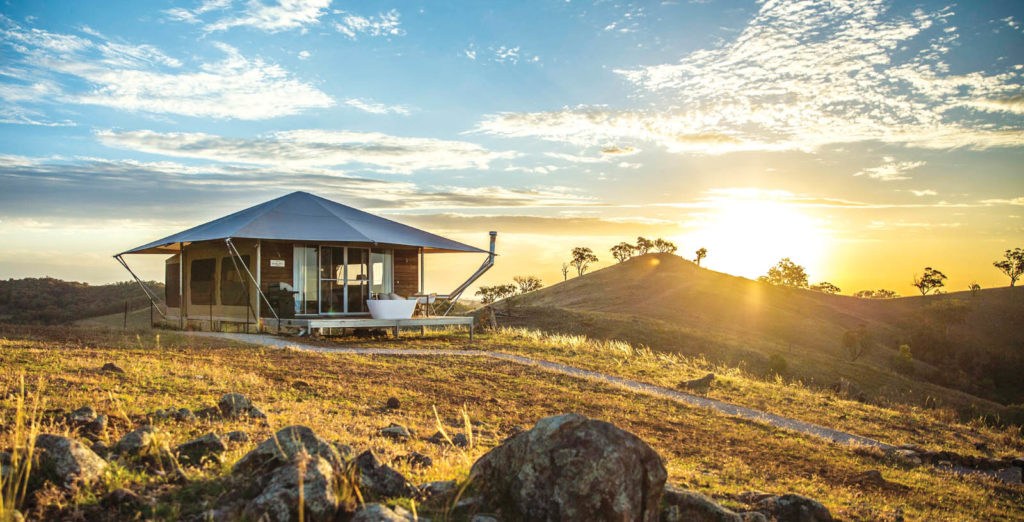
Glamping levels vary from the basic to the very deluxe, says Fife. As an example of the latter, she mentions one of Colorado Yurt’s installations, Escalante Yurts, a yurt glamping resort in southwest Utah. The yurts at this location have full bathrooms, kitchenettes and luxury furnishing. Because of its proximity to the Grand Staircase National Monument and the surrounding canyon country, the resort is popular with outdoor adventurers and families, Fife says, adding that a 20-acre expansion is planned.
Other terms—such as “experiential accommodation” and “experiential travel”—are becoming more entwined with glamping, says Tom Butterfield, sales and business development manager for Eco Structures. Headquartered in Fremantle, Western Australia, the company designs, manufactures and supplies a variety of environmentally sustainable glamping accommodations.
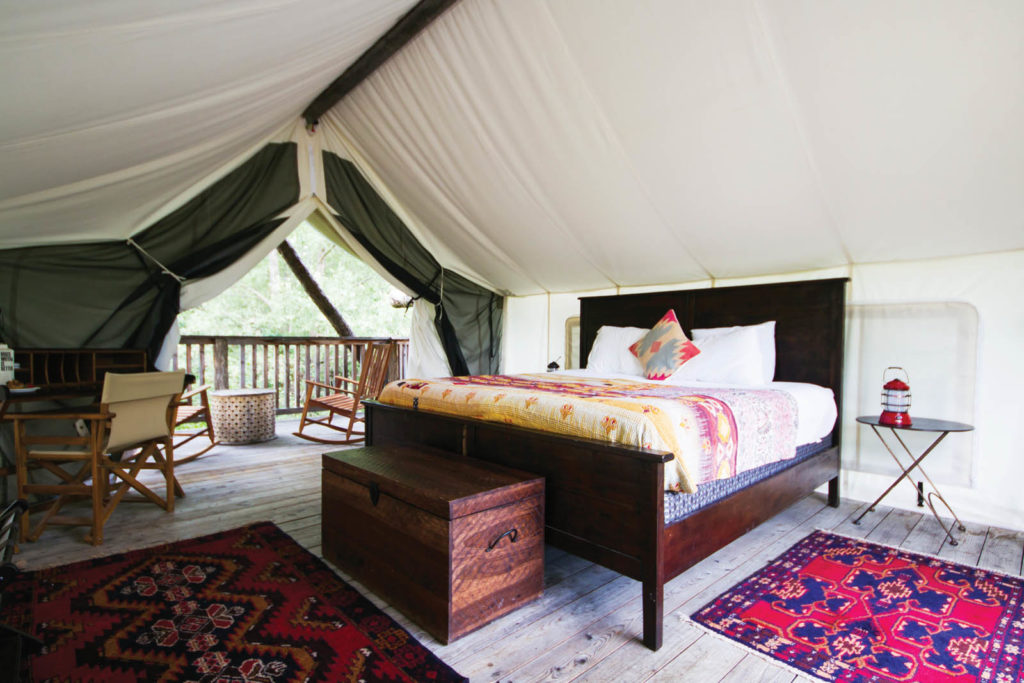
“[This] is essentially taking you out of a [hotel room] and transporting you to a tent that has been placed in the center of a location you’ve traveled so far to experience, all without [stinting] on the luxuries of the four- or five-star hotel experience,” he says, explaining those concepts.
The company’s flagship glamping product is the Eco Tent. Customers
are able to customize these structures, which are available in kit form, by selecting a variety of components and accessories, like bath-pod en suites, sliding glass front doors, luxury vinyl flooring and extended decking. Standard features include RT12 canvas walls and ceilings, WPC (wood plastic composite) internal and external flooring, shade net roof fly, floor joist and bearers.
The tents, which can serve as permanent structures and comply with Australia’s highest building code standards (they’re engineered and manufactured to the maximum cyclonic wind rating for any structure) are being used in large resort developments, smaller boutique retreats and holiday parks, as well as wineries, adventure camps and even Boy Scouts
of America camps.
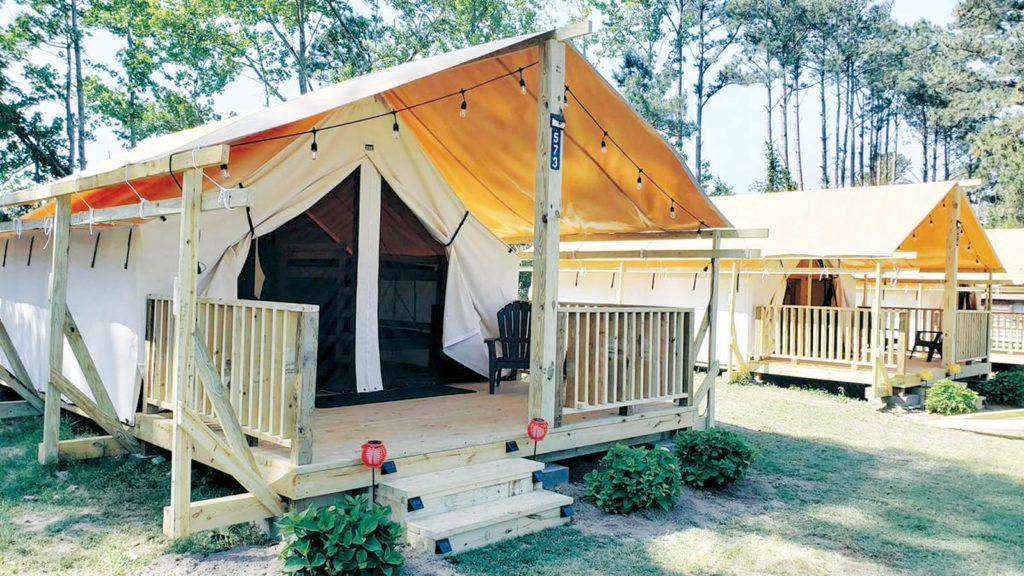
Demand accelerates
Butterfield says Eco Structures has been fielding inquiries from the larger hotel chains, predicting these brands and others will begin opening up 50- to 100-tent/room resorts “around the world at an accelerated pace.” Fife says Colorado Yurt is getting daily inquiries about its structures, attributing this in part to more hotel brands latching onto glamping. But demand is also being driven by the preference for “experienced-based lodging” (in particular coming from millennials and Gen Xers), which has propelled the emergence of more high-end adventure camps.
Since the company’s yurts are engineered, they can be left up year-round, says Fife, adding they can also meet the International Building Code. Installed on a platform, they’re able to withstand heavy winds and snow loads, although a snow and wind upgrade package might be required. Ranging from 200 square feet up to 706 square feet, the yurts are the most watertight of Colorado Yurt’s structures and are the easiest to heat and cool (glamping is more of a market for their yurts and tents, but tipis are also used).
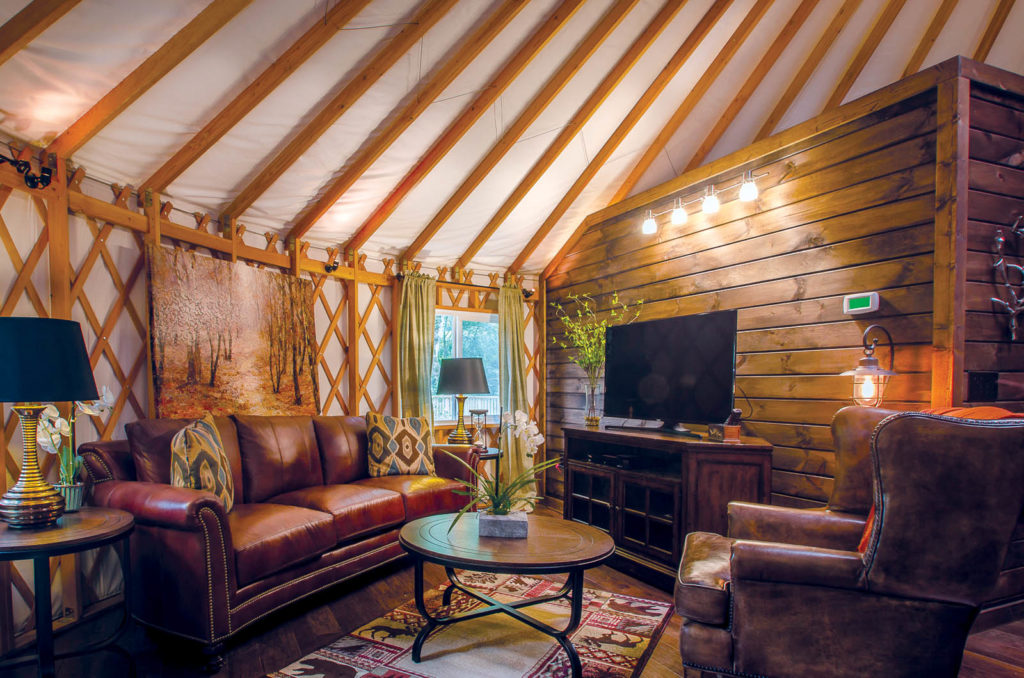
The company’s yurt walls are made from Protech vinyl laminate, which provides “exceptional” mildew and UV resistance and comes in 16 color choices, Fife says. All seams are thermally welded. The roofs are most commonly Duro-Last® and are available in white, tan or gray.
Alan Bair, president of Pacific Yurts Inc., says Airbnb, Hipcamp, Glamping Hub and other online sites are powering growth. The company, located in Cottage Grove, Ore., manufactures yurts inspired by the traditional Mongolian “Gers,” he says. These round structures incorporate Douglas fir framework covered by durable architectural fabrics, use NASA-developed radiant insulation, and come with a variety of optional features and upgrades allowing for customization. The structures can be installed in almost any climate.
“When glamping first came on the scene, we had campgrounds and resorts utilizing smaller yurts, like 14 foot and 16 foot, to provide somewhat rustic accommodations that were ‘better than camping,’” Bair explains. “This was more like convenience camping. You could open the door, put down your gear and you were ready to enjoy the outdoors—you didn’t have to set up camp.
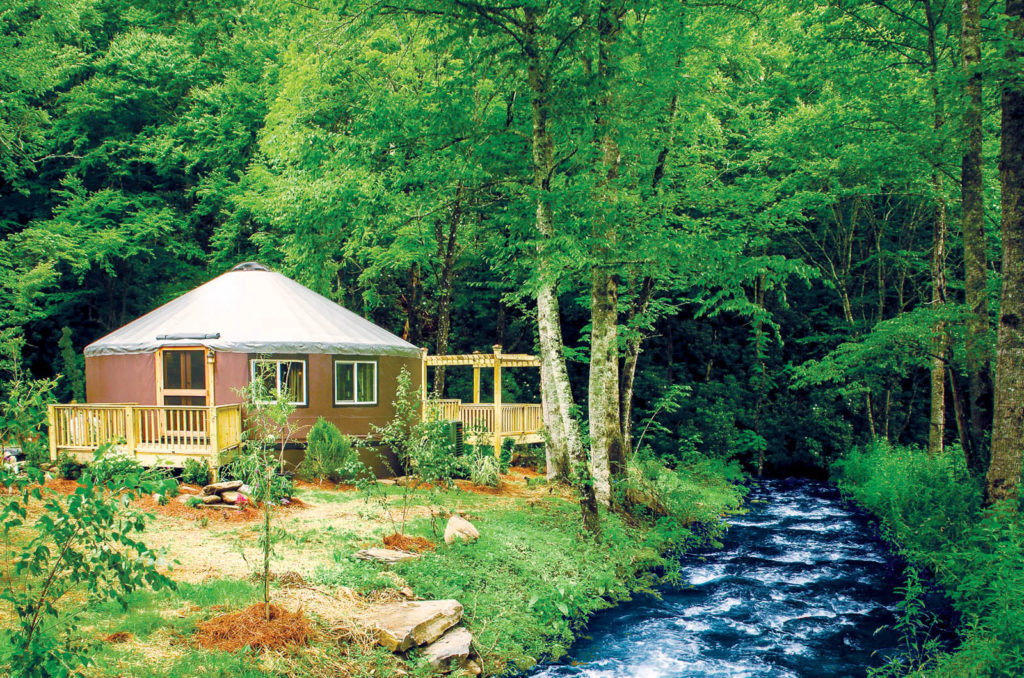
“Oregon State Parks discovered the popularity of this type of camping in the mid-1990s and ended up with close to 200 smaller yurt rentals, mostly scattered along the coastline,” he continues. “These are still in use and very popular. But now the trend is for full-service glamping rentals, which include a bedroom, bathroom and kitchen.”
Larger, insulated yurts—24 feet or 30 feet in diameter and ranging from 452 square feet to 706 square feet—are drawing attention, says Bair. These can be constructed to withstand snow loads of up to 100 pounds per square foot and 142 mph winds. But even with these dimensions, and whether installed temporarily or permanently, the yurts can still be dismantled and moved to another location.
Most commonly, the materials used in the yurts built by Pacific Yurts include a vinyl laminate polyester membrane for the roofing fabric and a fabric of woven polyester with acrylic coating for the exterior walls. The reflective insulation has two layers of air pockets, three layers of polyethylene and two of aluminum foil, all bonded into a 5/6-inch flexible and lightweight layer, which is then covered with a vinyl-coated polyester fabric liner.
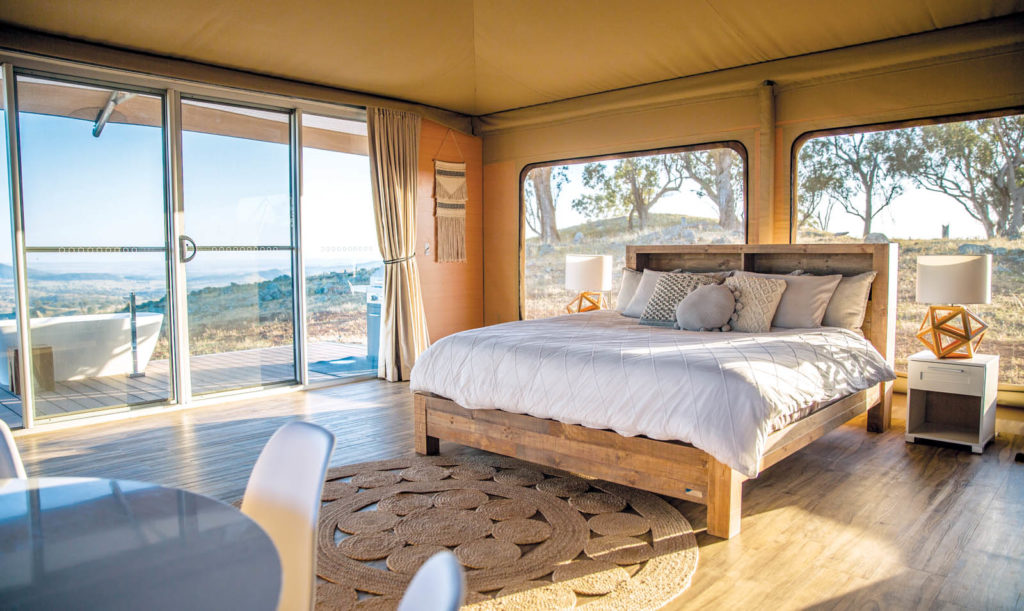
Looking ahead
Even decked out with amenities, these cabin-like yurts still allow people to feel close to nature, thanks to their fabric exteriors, says Bair. They provide plenty of comfort but nevertheless impart the feel of camping, which he describes as “the essence of glamping” today.
He mentions a project at Stay Nantahala near Topton, N.C. The four 30-foot-diameter Pacific yurts installed there incorporate the company’s insulated glass window system and include wood flooring, wood partition walls, stone countertops and brown leather furniture, along with a stacked washer/dryer, full kitchen, a walk-in shower, an outdoor deck with hot tub, pergola and a patio area with a fire pit.
Butterfield recalls a project involving a private safari lodge in Africa where Eco Structures delivered nine of its “ultra-luxury” tents/homes as one of his favorites. “We designed not only two- and three-bedroom suites, but also a gym, bar and restaurant,” he says. “I can’t wait for the day we deliver the same for the rest of the world to experience.”
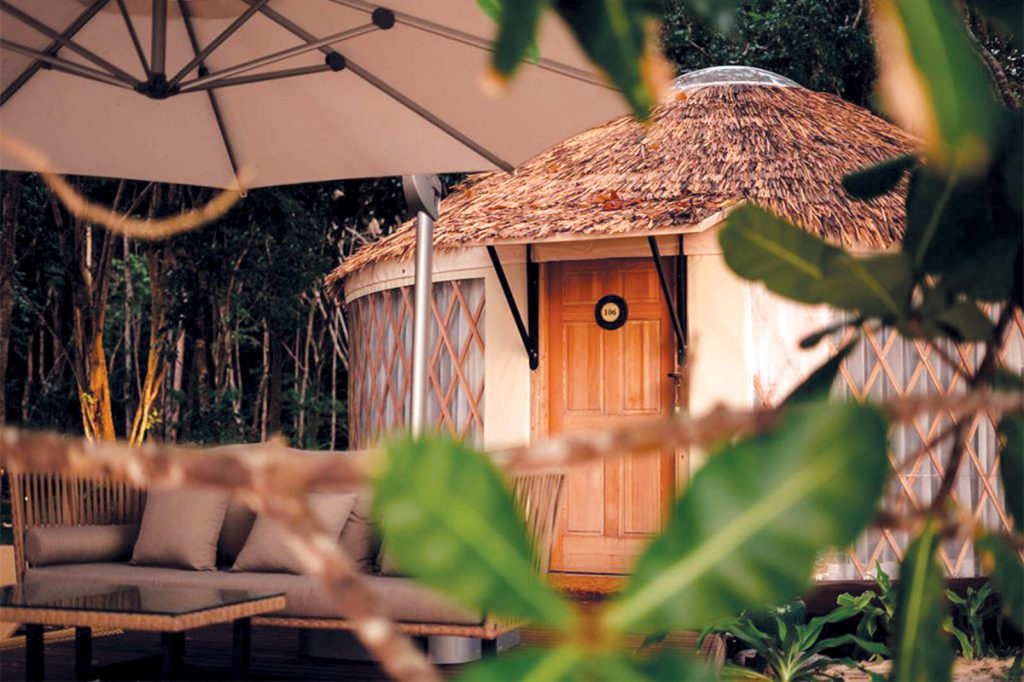
Dana Hendel, design and sales consultant for Rainier Outdoor, is equally excited about glamping’s future prospects. Located in Tukwila, Wash., the company provides handcrafted yurts, canvas cottages, tipis and wall tents. These are found in all manner of environments, from the deep backcountry, to island resorts, Airbnb, and glamping locations worldwide.
“Our customers range from large corporations buying multiple units to individuals retiring to the woods,” says Hendel. “The typical glamping resort will have multiple units, perhaps in different sizes to accommodate couples or families, with a spectacular outdoor playground at their door.”
Rainier Outdoor’s yurts vary from 16 feet in diameter up to 33 feet with 855 square-feet of living space and room for a loft. Consider the company’s Eagle yurt. It incorporates a dome skylight at the top, machine stress-rated Douglas fir rafters and lattice walls, and a roof of vinyl-coated polyester with a lacquer acrylic topcoat. Its sidewalls, made from Patio 500 fabric, are reinforced vinyl with an acrylic topcoat for water repellency, UV resistance and flame retardancy. The yurts can serve as temporary or permanent structures.

“The glamping market is hot,” says Hendel. “Just yesterday I quoted for one entity 12 Lakedale Canvas Cottages with three windows and screens, and safari flap front with bug screens; four two-person tipis for a queen bed; three four-person tipis for a queen bed plus two twin cots; and a 33-foot Eagle yurt with insulation and a clear opening dome.”
Before this, the company received an inquiry about three 27-foot Eagle yurts for an existing “glamp-ground” that already has several of its yurts. And in the queue is an order for 15 Eagle yurts heading to the Jeju Nine Bridges PGA Golf Resort in South Korea.
A memorable installation for Hendel was at a high-end glamping resort island in Southeast Asia where 24 Eagle yurts, each 21 feet, now dot the white sandy beach.
“We invented our new Panorama Window on this order,” she recalls, explaining this is a floor-to-ceiling window affording maximum viewing. “Due to the size, RF welding was required on the 30 mil clear vinyl to create the massive span. Material widths, yields, form and function all played into how the window came to light.”
Hendel predicts the enthusiasm for glamping will surge in the years ahead, in part because of its appeal to millennials and young families.
“I tell my clients, ‘If you build it, they will come,’” she says. “I suppose a downturn in the economy would have a negative effect on glamping, as luxury items and leisure travel are two of the top opportunities to get cut from one’s budget. But then again, it might just be an opportunity for people to sell their traditional home and move into a yurt or canvas cottage.”
Pamela Mills-Senn is a writer based in Long Beach, Calif.
SIDEBAR: A glamping-inspired rebrand

Brenda Hagerty is president of both Porcupine Canvas Manufacturing Ltd. and Tenting in Luxury. Located on Montreal’s south shore in Boucherville, Quebec, the companies manufacture a broad array of products, including bags and cases primarily used by the mining industry, as well as tipis and other structures used by aboriginals.
For the past 20 years, both companies have also produced canvas wall tents traditionally used by exploration companies. But around 10 years ago, they were asked by a client to produce these for his glamping site, which they did, says Hagerty.
“A few years later, we were getting more inquiries from the newly emerging glamping industry,” she recalls. “We decided to rebrand our tent division and that is how Tenting in Luxury was developed.”
They fabricate two models of wall tents—one in a “true prospector style,” which is hung from an exterior pole structure, and an internal-frame-style tent—selling these to glamping resorts, hotels and campgrounds as well as to people who want an additional sleep structure for their cottages. Tents going to areas in Canada or the northern U.S. are typically up for three seasons. Glamping is more active in the warmer climates, like California, Texas, Arizona, Florida and New Mexico, with these locations generally being year-round, Hagerty says.
“We use a specially treated canvas to construct our tents,” she explains. “The structures are primarily built out of either wood poles or old barn wood. The point of glamping is to be eco-friendly and have the least amount of environmental impact. The fabrics need to be fire retardant and also need to breathe, making for a more comfortable experience.”
Hagerty believes glamping is just getting started and that it is poised to grow “exponentially” each year for decades to come.
“There are so many possibilities for marketplaces, and people are definitely trying to be more conscious about the environment,” she explains. “Glamping is way more well-known by the public today than it was 10 years ago, which is what is fueling the growth of the industry. People like to try new things and glamping fits the bill.
 TEXTILES.ORG
TEXTILES.ORG


